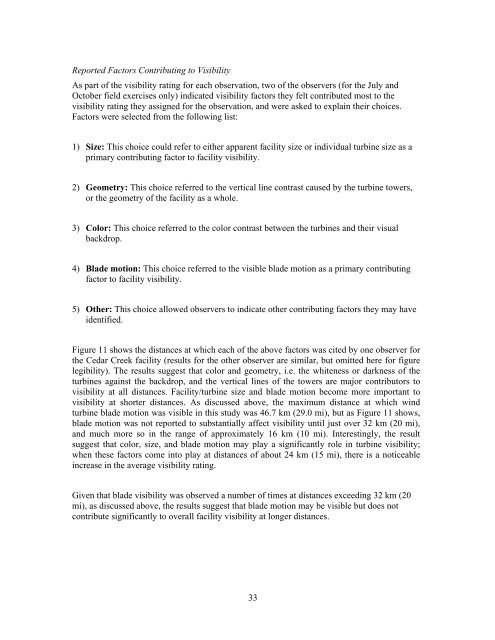Wind Turbine Visibility and Visual Impact Threshold Distances in ...
Wind Turbine Visibility and Visual Impact Threshold Distances in ...
Wind Turbine Visibility and Visual Impact Threshold Distances in ...
You also want an ePaper? Increase the reach of your titles
YUMPU automatically turns print PDFs into web optimized ePapers that Google loves.
Reported Factors Contribut<strong>in</strong>g to <strong>Visibility</strong><br />
As part of the visibility rat<strong>in</strong>g for each observation, two of the observers (for the July <strong>and</strong><br />
October field exercises only) <strong>in</strong>dicated visibility factors they felt contributed most to the<br />
visibility rat<strong>in</strong>g they assigned for the observation, <strong>and</strong> were asked to expla<strong>in</strong> their choices.<br />
Factors were selected from the follow<strong>in</strong>g list:<br />
1) Size: This choice could refer to either apparent facility size or <strong>in</strong>dividual turb<strong>in</strong>e size as a<br />
primary contribut<strong>in</strong>g factor to facility visibility.<br />
2) Geometry: This choice referred to the vertical l<strong>in</strong>e contrast caused by the turb<strong>in</strong>e towers,<br />
or the geometry of the facility as a whole.<br />
3) Color: This choice referred to the color contrast between the turb<strong>in</strong>es <strong>and</strong> their visual<br />
backdrop.<br />
4) Blade motion: This choice referred to the visible blade motion as a primary contribut<strong>in</strong>g<br />
factor to facility visibility.<br />
5) Other: This choice allowed observers to <strong>in</strong>dicate other contribut<strong>in</strong>g factors they may have<br />
identified.<br />
Figure 11 shows the distances at which each of the above factors was cited by one observer for<br />
the Cedar Creek facility (results for the other observer are similar, but omitted here for figure<br />
legibility). The results suggest that color <strong>and</strong> geometry, i.e. the whiteness or darkness of the<br />
turb<strong>in</strong>es aga<strong>in</strong>st the backdrop, <strong>and</strong> the vertical l<strong>in</strong>es of the towers are major contributors to<br />
visibility at all distances. Facility/turb<strong>in</strong>e size <strong>and</strong> blade motion become more important to<br />
visibility at shorter distances. As discussed above, the maximum distance at which w<strong>in</strong>d<br />
turb<strong>in</strong>e blade motion was visible <strong>in</strong> this study was 46.7 km (29.0 mi), but as Figure 11 shows,<br />
blade motion was not reported to substantially affect visibility until just over 32 km (20 mi),<br />
<strong>and</strong> much more so <strong>in</strong> the range of approximately 16 km (10 mi). Interest<strong>in</strong>gly, the result<br />
suggest that color, size, <strong>and</strong> blade motion may play a significantly role <strong>in</strong> turb<strong>in</strong>e visibility;<br />
when these factors come <strong>in</strong>to play at distances of about 24 km (15 mi), there is a noticeable<br />
<strong>in</strong>crease <strong>in</strong> the average visibility rat<strong>in</strong>g.<br />
Given that blade visibility was observed a number of times at distances exceed<strong>in</strong>g 32 km (20<br />
mi), as discussed above, the results suggest that blade motion may be visible but does not<br />
contribute significantly to overall facility visibility at longer distances.<br />
33


